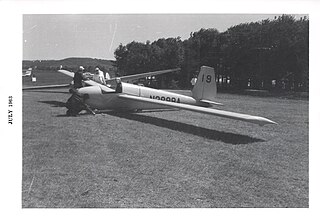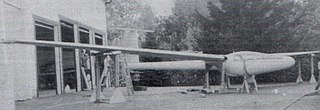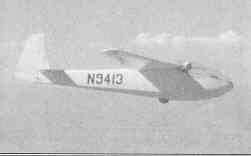Related Research Articles
The Advanced Soaring Concepts Spirit, also called the Advanced Soaring Concepts American Spirit, is an American mid-wing, T-tailed. single-seat, FAI Standard Class glider that was designed by Tor Jensen and produced by Advanced Soaring Concepts, first flying in 1992. The aircraft was produced in kit form for amateur construction.

The Schweizer SGS 1-29 is an American single-seat, mid-wing, experimental laminar flow airfoil glider built by Schweizer Aircraft of Elmira, New York.

The Schweizer SGS 1-35 is a United States 15 Meter Class, single-seat, mid-wing glider built by Schweizer Aircraft of Elmira, New York.

The Neukom Elfe is family of Swiss single-seat high-performance sailplane designs.

The Glasflügel BS-1, sometimes called the Björn Stender BS-1 or the Stender BS-1, is a West German, high-wing, single seat, T-tailed, FAI Open Class glider that was designed by Björn Stender and produced by Glasflügel.

The Scheibe Bergfalke is a German glider designed by Egon Scheibe as a post-World War II development of the Akaflieg München Mü13 produced before and during the war.
The Applebay Zuni and Zuni II are single-seat, water-ballasted gliders designed to compete in the FAI 15m class.
The Applebay Zia is an American, single-seat, high-wing, twin-boom, pusher configuration motor glider that was designed by George Applebay for the 1982 Sailplane Homebuilders Association Homebuilt Sailplane Design Contest. The aircraft was intended to be offered as a factory completed aircraft or as a kit.

The Hall Cherokee II is an American high-wing, single seat glider that was designed by Stan Hall and introduced in 1956 as plans for amateur construction.

The Schreder Airmate HP-8 is an American, high-wing single seat glider that was designed by Richard Schreder after the loss of the HP-7 in 1957.
The Schreder HP-19 is an American, high-wing, T-tail, single seat glider designed by Richard Schreder.
The Chase-Sisley C100-S is an American mid-wing, single seat FAI Open Class glider that was designed in the 1960s by Dr. Robert Chase.

The Luenger Beta 1 was an American high-wing, single-seat, T-tailed FAI Open Class glider designed by Hans Luenger and Spud Kohler.

The US Southwest Soaring Museum is an aviation museum, located at 918 E US Route 66, in Moriarty, New Mexico, United States that focuses on the history of gliding in the western United States. The museum is an affiliate member of the Soaring Society of America.
The Applebay GA-111 Mescalero is an American high-wing, T-tailed single-seat, FAI Open Class glider that was designed by George Applebay.
The Monaghan Osprey is an American mid-wing, single-seat, T-tailed, FAI Standard Class glider that was designed and constructed by Richard C. Monaghan of Pearblossom, California.
The Parker RP9 T-Bird is an American, high-wing, T-tailed, single-seat, FAI Open Class glider that was designed and constructed by Ray Parker between 1956 and 1962.

The FFA Diamant is a family of Swiss high-wing, T-tailed, single-seat, FAI Standard Class and FAI Open Class gliders that was designed by engineering students under supervision of Professor Rauscher at the ETH Zurich and manufactured by Flug- und Fahrzeugwerke Altenrhein AG (FFA) of Altenrhein, Switzerland.

The Rubik R-26 Góbé is a family of Hungarian shoulder-wing, two-seat training gliders that was designed by Ernő Rubik Sr., and produced by Auto-Aero. After its introduction the R-26 Góbé became the de facto training glider type in Hungary and is still used by many clubs for basic instruction.

The Applebay GA-II Chiricahua is an American high-wing, single-seat, FAI Standard Class glider that was designed and constructed by George Applebay, first flying in 1970.
References
- ↑ Activate Media (2006). "Manufacturers Details". Archived from the original on April 2, 2015. Retrieved March 10, 2015.
- 1 2 3 Said, Bob: 1983 Sailplane Directory, Soaring Magazine , page 34, 48 and 133. Soaring Society of America November 1983. USPS 499-920
- 1 2 Simons, Martin. Sailplanes 1965-2000”. 2nd revised edition. EQIP Werbung und Verlag G.m.b.H.. Königswinter. 2005. ISBN 3-9808838-1-7
- ↑ Activate Media (2006). "Chiricahua GA-II Applebay". Archived from the original on August 29, 2012. Retrieved March 10, 2015.
- ↑ Activate Media (2006). "Mescalero Applebay". Archived from the original on August 19, 2012. Retrieved March 10, 2015.
- 1 2 Applebay Zuni II, National Air and Space Museum. Accessed 2010-11-05.
- ↑ Activate Media (2006). "Zia Applebay". Archived from the original on September 24, 2015. Retrieved March 10, 2015.
- ↑ Staff (April 29, 2010). "Hall Inducts Two Aviation Legends". Mountain View Telegraph. Archived from the original on May 20, 2015. Retrieved March 10, 2015.
- ↑ Kauh, Elaine (June 26, 2015). "Soaring Pioneer George Applebay Dies At 89". AVweb. Retrieved June 29, 2015.